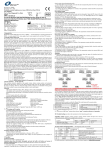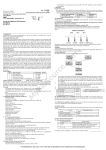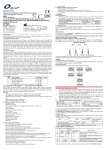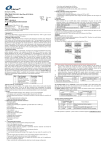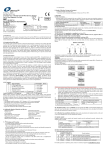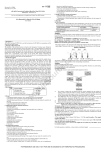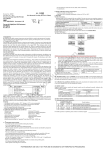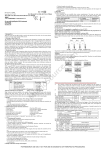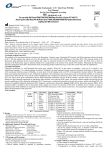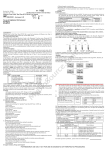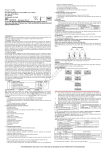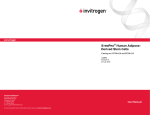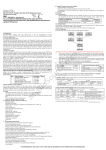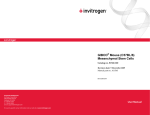Download (H1N1) Real Time RT-PCR Kit
Transcript
For use with LightCycler1.0/2.0 Instrument Specimens for the laboratory diagnosis of avian influenza A should be collected in the following order of priority: Nasopharyngeal aspirate Convalescent serum Acute serum 9.1.3 RNA extraction kits Different brand RNA extraction kits are available. You may use your own extraction systems or the commercial kit based on the yield. For the RNA extraction, please comply with the manufacturer’s instructions. The recommended Extraction kit is as follows: Nucleic Acid Isolation Kit Cat. Number Manufacturer RNA Isolation Kit ME-0001 ZJ Biotech QIAamp Viral RNA Mini extraction Kit (50) 52904 QIAGEN 9.2 Internal Control It is necessary to add internal control (IC) in the reaction mix. Internal Control (IC) allows the user to determine and control the possibility of PCR inhibition. Add the internal control (IC) 1μl/rxn and the result will be shown in the 560nm. 9.3 RT-PCR Protocol 1) Preparation of positive control and negative control It is necessary to dilute the positive control and internal control supplied in the kit by 10 times with molecular grade water before detection, and close the tube immediately then vortex for 10 seconds. 2) The Master Mix volume for each reaction should be pipetted as follows: Attention: PCR system without 560nm channel (e.g. LightCycler1.0) can be treated with 1μl Molecular Grade Water instead of 1μl Internal Control. ur 1. Intended Use New Influenza A virus (H1N1) real time RT-PCR kit is used for the detection of new reassortment Influenza A virus (H1N1) by using real time PCR systems. 2. Principle of Real-Time RT-PCR RT-PCR (Reverse Transcription-Polymerase Chain Reaction) is a technique in which an RNA strand is "reverses" transcribed into its DNA complement, followed by amplification of the resulting DNA using a polymerase chain reaction (PCR). RT-PCR can be used to examine gene expression level in cells and tissues, clone the specific gene of cDNA sequences and test RNA viruses. One Step RT-PCR Kit adopts one tube system. Because operator doesn’t need to open the lid during the reaction process, this user-friendly improved version avoids cross contamination. 3. Product Description Influenza A virus subtype H1N1 (A/H1N1), is a subtype of influenza A virus .It is the most common cause of influenza (flu) in humans. Some strains of H1N1 are endemic in humans, including the strain(s) responsible for the 1918 flu pandemic which killed 50–100 million people worldwide. Less virulent H1N1 strains still exist in the wild today, worldwide, causing a small fraction of all influenza-like illness and a large fraction of all seasonal influenza. In March and April 2009, hundreds of laboratory-confirmed infections and a number of deaths were caused by an outbreak of a new strain of H1N1. The new Influenza A virus real time RT-PCR kit contains a specific ready-to-use system for the detection of the new Influenza A virus (H1N1) using RT-PCR in the real-time PCR system. The primer and probe is designed for specifically detect new influenza virus (H1N1) with new reassortment genome.The reaction is done in one step real time RT-PCR. The first step is a reverse transcription (RT), during which the virus RNA is transcribed into cDNA. Afterwards, a thermostable DNA polymerase is used to amplify the specific gene fragments by means of PCR (polymerase chain reaction). Fluorescence is emitted and measured by the real time systems´ optical unit during the PCR. The detection of amplified virus DNA fragment is performed in fluorimeter channel 530nm with the fluorescent quencher BHQ1. An external positive control is supplied which allow the determination of the gene load. Internal control is available in the kit. It can be used for monitoring the yield of the nucleic acid extraction and whether there existing inhibition in the sample or not. 4. Kit Contents Ref. Type of reagent Presentation 25rxns 1 New H1N1 Super Mix 1 vial, 350l 2 RT-PCR Enzyme Mix 1 vial, 28l 3 Molecular Grade Water 1 vial, 400μl 4 New H1N1 Positive Control 1 vial, 30μl 5 Internal Control 1 vial, 30μl Analysis sensitivity: 1×104copies/ml. om MBS598296 - Instrument I, II .c (For Research Use Only In USA & China) New Influenza A Virus (H1N1) Real Time RT-PCR Kit User Manual ce Revision No.: ZJ0008 Issue Date: Jul 1st, 2015 8. Sample Collection, Storage and transport • Collected samples in sterile tubes; • Specimens can be extracted immediately or frozen at -20°C to -80°C. • Transportation of clinical specimens must comply with local regulations for the transport of etiologic agents 9. Procedure 9.1 RNA-Extraction 9.1.1 Type of specimens A variety of specimens are suitable for the diagnosis of virus infections of the upper respiratory tract: Nasal swab Nasopharyngeal aspirate Nasopharyngeal swab Throat swab In addition to swabs from the upper respiratory tract, invasive procedures can be performed for the diagnosis of virus infections of the lower respiratory tract where clinically indicated: Transtracheal aspirate Lung biopsy Bronchoalveoar lavage Post-mortem lung or tracheal tissue M yB io So 3) The volumes of Super Mix and Enzyme Mix per reaction multiply with the number of reaction, which includes the number of controls, standards, and sample prepared. Molecular Grade Water is used as the negative control. For reasons of unprecise pipetting, always add an extra virtual sample. Mix Note: Analysis sensitivity depends on the sample volume, elution volume, nucleic acid extraction methods and other factors .If you use the RNA extraction kits recommended, the analysis sensitivity is the same as it declares. However, when the sample volume is dozens or even hundreds of times greater than elution volume by some concentrating method, it can be much higher. 5. Storage • All reagents should be stored at -20°C. Storage at +4°C is not recommended. • All reagents can be used until the expiration date indicated on the kit label. • Repeated thawing and freezing (> 3x) should be avoided, as this may reduce the sensitivity of the assay. • Cool all reagents during the working steps. • Super Mix should be stored in the dark. 6. Additionally Required Materials and Devices • Biological cabinet • Vortex mixer • Real time PCR system • RNA extraction kit • Real time PCR reaction tubes/plates • Cryo-container • Pipets (0.5 μl – 1000 μl) • Sterile filter tips for micro pipets • Sterile microtubes • Disposable gloves, powderless • Biohazard waste container • Refrigerator and freezer • Desktop microcentrifuge for “eppendorf” type tubes (RCF max. 16,000 x g) • Tube racks 7. Warnings and Precaution Carefully read this instruction before starting the procedure. • For in vitro diagnostic use only. • This assay needs to be carried out by skilled personnel. • Clinical samples should be regarded as potentially infectious materials and should be prepared in a laminar flow hood. • This assay needs to be run according to Good Laboratory Practice. • Do not use the kit after its expiration date. • Avoid repeated thawing and freezing of the reagents, this may reduce the sensitivity of the test. • Once the reagents have been thawed, vortex and centrifuge briefly the tubes before use. • Prepare quickly the Reaction mix on ice or in the cooling block. • Set up two separate working areas: 1) Isolation of the RNA/ DNA and 2) Amplification/ detection of amplification products. • Pipets, vials and other working materials should not circulate among working units. • Use always sterile pipette tips with filters. • Wear separate coats and gloves in each area. • Do not pipette by mouth. Do not eat, drink, smoke in laboratory. • Avoid aerosols completely then spin down briefly in a centrifuge. 1) Pipet 15μl Master Mix with micropipets of sterile filter tips to each of the Real time PCR reaction plate/tubes. Separately add 5μl RNA sample supernatantor positive and negative controls to different reaction plate/tubes. Immediately close the plate/tubes to avoid contamination. 2) Spin down briefly in order to collect the Master Mix in the bottom of the reaction tubes. 3) Perform the following protocol in the instrument: 45°C for 10min 95°C for 15min 95°C for 5sec, 60°C for 30sec ( Fluorescence measured at 60°C) 1cycle 1cycle 45cycles Selection of fluorescence channels 530nm Target Nucleic Acid 560nm IC 10. Threshold setting: Choose Arithmetic as back ground and none as Noise Band method, then adjust the Noise band just above the maximum level of molecular grade water, and adjust the threshold just under the minimum of the positive control. 11.Quality control: Negative control, positive control, and internal control must be performed correctly, otherwise the sample results is invalid. Channel Crossing point value Control 530nm 560nm Molecular Grade Water Blank 25~35 Positive Control(qualitative assay) ≤35 —— 12. Data Analysis and Interpretation :The following sample results are possible: Crossing point value Result Analysis 530nm 560nm 1# Blank 25~35 Below the detection limit or negative 2# Positive; New Influenza A virus H1 subtype's genome ≤43 —— bears strong resemblance to the genome of strain A/California/04/2009.If the results are obtained, it is likely that a new reassortment of the New Influenza A virus has emerged. 3# 25~35 Re-test; If it is still 38~40, report as 1# 43~45 4# Blank Blank PCR Inhibition; No diagnosis can be concluded. For further questions or problems,please contact our technical support FOR RESEARCH USE ONLY. NOT FOR USE IN DIAGNOSTIC OR THERAPEUTIC PROCEDURES. • Avoid aerosols Revision No.: ZJ0005 Issue Date: Jul 1st, 2015 (For Research Use Only In USA & China) New Influenza A Virus (H1N1) Real Time RT-PCR Kit User Manual MBS598296 - Instrument III, IV For use with ABI Prism®7000/7300/7500/7900/Step One Plus; iCycler iQ™4/iQ™5; Smart Cycler II;Bio-Rad CFX 96;Rotor Gene™6000; Mx3000P/3005P;MJ-Option2/Chromo4; LightCycler®480 Instrument 8. Sample Collection, Storage and transport • Collected samples in sterile tubes; • Specimens can be extracted immediately or frozen at -20°C to -80°C. • Transportation of clinical specimens must comply with local regulations for the transport of etiologic agents 9. Procedure 9.1 RNA-Extraction 9.1.1 Type of specimens A variety of specimens are suitable for the diagnosis of virus infections of the upper respiratory tract: Nasal swab Nasopharyngeal aspirate Nasopharyngeal swab Throat swab In addition to swabs from the upper respiratory tract, invasive procedures can be performed for the diagnosis of virus infections of the lower respiratory tract where clinically indicated: Transtracheal aspirate Lung biopsy Bronchoalveoar lavage Post-mortem lung or tracheal tissue M yB io So ur ce .c om Specimens for the laboratory diagnosis of avian influenza A should be collected in the following order of priority: 1. Intended Use Nasopharyngeal aspirate Convalescent serum New Influenza A virus (H1N1) real time RT-PCR kit is used for the detection of new Acute serum reassortment Influenza A virus (H1N1) by using real time PCR systems. 9.1.2 RNA extraction kits 2. Principle of Real-Time RT-PCR Different brand RNA extraction kits are available. You may use your own RT-PCR (Reverse Transcription-Polymerase Chain Reaction) is a technique in which an extraction systems or the commercial kit based on the yield. For the RNA RNA strand is "reverses" transcribed into its DNA complement, followed by extraction, please comply with the manufacturer’s instructions. The recommended amplification of the resulting DNA using a polymerase chain reaction (PCR). RT-PCR Extraction kit is as follows: can be used to examine gene expression level in cells and tissues, clone the specific gene Nucleic Acid Isolation Kit Cat. Number Manufacturer of cDNA sequences and test RNA viruses. One Step RT-PCR Kit adopts one tube system. RNA Isolation Kit ME-0010/ME-0012 ZJ Biotech Because operator doesn’t need to open the lid during the reaction process, this QIAamp Viral RNA Mini extraction 52904 QIAGEN user-friendly improved version avoids cross contamination. Kit(50) 3. Product Description Respiratory specimens should be collected and transported in virus transport media. Influenza A virus subtype H1N1 (A/H1N1), is a subtype of influenza A virus .It is the Virus transport medium most common cause of influenza (flu) in humans. Some strains of H1N1 are endemic in (A) Virus transportation medium use in collecting throat and nasal swabs humans, including the strain(s) responsible for the 1918 flu pandemic which killed 1) Add 10g veal infusion broth and 2g bovine albumin fraction V to sterile distilled water 50–100 million people worldwide. Less virulent H1N1 strains still exist in the wild today, (to 200ml). 2)Add 0.8ml gentamicin sulfate solution(50mg/ml) and 3.2ml amphotericin worldwide, causing a small fraction of all influenza-like illness and a large fraction of all B(250μg/ml). 3) Sterilize by filtration. seasonal influenza. In March and April 2009, hundreds of laboratory-confirmed B)Nasal wash medium: Sterile saline(0.85% NaCl) infections and a number of deaths were caused by an outbreak of a new strain of H1N1. 9.2 Internal Control The new Influenza A virus real time RT-PCR kit contains a specific ready-to-use system It is necessary to add internal control (IC) in the reaction mix. Internal Control (IC) for the detection of the new Influenza A virus (H1N1) using RT-PCR in the real-time PCR system. The primer and probe is designed for specifically detect new influenza virus allows the user to determine and control the possibility of PCR inhibition. Add the internal control (IC) 1μl/rxn and the result will be shown in the HEX/VIC/JOE. (H1N1) with new reassortment genome.The reaction is done in one step real time 9.3 RT-PCR Protocol RT-PCR. The first step is a reverse transcription (RT), during which the virus RNA is The Master Mix volume for each reaction should be pipetted as follows: transcribed into cDNA. Afterwards, a thermostable DNA polymerase is used to amplify the specific gene fragments by means of PCR (polymerase chain reaction). Fluorescence 1) The volumes of Super Mix and is emitted and measured by the real time systems´ optical unit during the PCR. The Enzyme Mix per reaction detection of amplified virus DNA fragment is performed in fluorimeter channel FAM multiply with the number of with the fluorescent quencher BHQ1. An external positive control is supplied which reaction, which includes the allow the determination of the gene load. number of controls, standards, Internal control is available in the kit. It can be used for monitoring the yield of the and sample prepared. Molecular nucleic acid extraction and whether there existing inhibition in the sample or not. Grade Water is used as the 4. Kit Contents negative control. For reasons of Ref. Type of reagent Presentation 25rxns unprecise pipetting, always add 1 New H1N1 Super Mix 1 vial, 480l an extra virtual sample. Mix 2 RT-PCR Enzyme Mix 1 vial, 28l completely then spin down 3 Molecular Grade Water 1 vial, 400μl briefly in a centrifuge. 4 New H1N1 Positive Control 1 vial, 30μl 2) Pipet 20μl Master Mix with micropipets of sterile filter tips to each of the Real time 5 Internal Control 1 vial, 30μl PCR reaction plate/tubes. Separately add 5μl RNA sample supernatantor positive Analysis sensitivity: 5×103copies/ml. and negative controls to different reaction plate/tubes. Immediately close the Note: Analysis sensitivity depends on the sample volume, elution volume, nucleic acid extraction plate/tubes to avoid contamination. methods and other factors .If you use the RNA extraction kits recommended, the analysis sensitivity is the same as it declares. However, when the sample volume is dozens or even hundreds of times greater 3) Spin down briefly in order to collect the Master Mix in the bottom of the reaction than elution volume by some concentrating method, it can be much. tubes. 5. Storage 4) Perform the following protocol in the instrument: • All reagents should be stored at -20°C. Storage at +4°C is not recommended. • All reagents can be used until the expiration date indicated on the kit label. • Repeated thawing and freezing (> 3x) should be avoided, as this may reduce the sensitivity of the assay. • Cool all reagents during the working steps. • Super Mix should be stored in the dark. 6. Additionally Required Materials and Devices • Biological cabinet • Vortex mixer • Real time PCR system • RNA extraction kit • Real time PCR reaction tubes/plates • Cryo-container • Pipets (0.5 μl – 1000 μl) • Sterile filter tips for micro pipets • Sterile microtubes • Disposable gloves, powderless • Biohazard waste container • Refrigerator and freezer • Desktop microcentrifuge for “eppendorf” type tubes (RCF max. 16,000 x g) • Tube racks 45°C for 10min 95°C for 15min 95°C for 15sec, 60°C for 1min ( Fluorescence measured at 60°C) 1cycle 1cycle 45cycles Selection of fluorescence channels FAM Target Nucleic Acid HEX/VIC/JOE IC ® 5) If you use ABI Prism system, please choose “none” as passive reference and quencher. 10.Threshold setting: just above the maximum level of molecular grade water. 11.Quality control: Negative control, positive control, and internal control must be performed correctly, otherwise the sample results is invalid. Channel Ct value Control FAM HEX/VIC/JOE Molecular Grade Water UNDET 25~35 Positive Control(qualitative assay) ≤35 —— 7. Warnings and Precaution 12. Data Analysis and Interpretation : The following sample results are possible: •Carefully read this instruction before starting the procedure. Ct value • For in vitro diagnostic use only. Result Analysis FAM HEX/VIC/JOE • This assay needs to be carried out by skilled personnel. • Clinical samples should be regarded as potentially infectious materials and 1# UNDET 25~35 Below the detection limit or negative should be prepared in a laminar flow hood. 2# Positive; New Influenza A virus H1 subtype's ≤43 —— • This assay needs to be run according to Good Laboratory Practice. genome bears strong resemblance to the genome • Do not use the kit after its expiration date. of strain A/California/04/2009.If the results are • Avoid repeated thawing and freezing of the reagents, this may reduce the sensitivity of the test. obtained, it is likely that a new reassortment of • Once the reagents have been thawed, vortex and centrifuge briefly the tubes before use. the New Influenza A virus has emerged. • Prepare quickly the Reaction mix on ice or in the cooling block. • Set up two separate working areas: 1) Isolation of the RNA/ DNA and 2) Amplification/ detection of 3# 25~35 Re-test; If it is still 38~40, report as 1# 43~45 amplification products. 4# UNDET UNDET PCR Inhibition; No diagnosis can be concluded. • Pipets, vials and other working materials should not circulate among working units. For further questions or problems , please contact our technical support • Use always sterile pipette tips with filters. • Wear separate coats and gloves in each area. • Do not pipette by mouth. Do not eat, drink, smoke in laboratory. FOR RESEARCH USE ONLY. NOT FOR USE IN DIAGNOSTIC OR THERAPEUTIC PROCEDURES.


